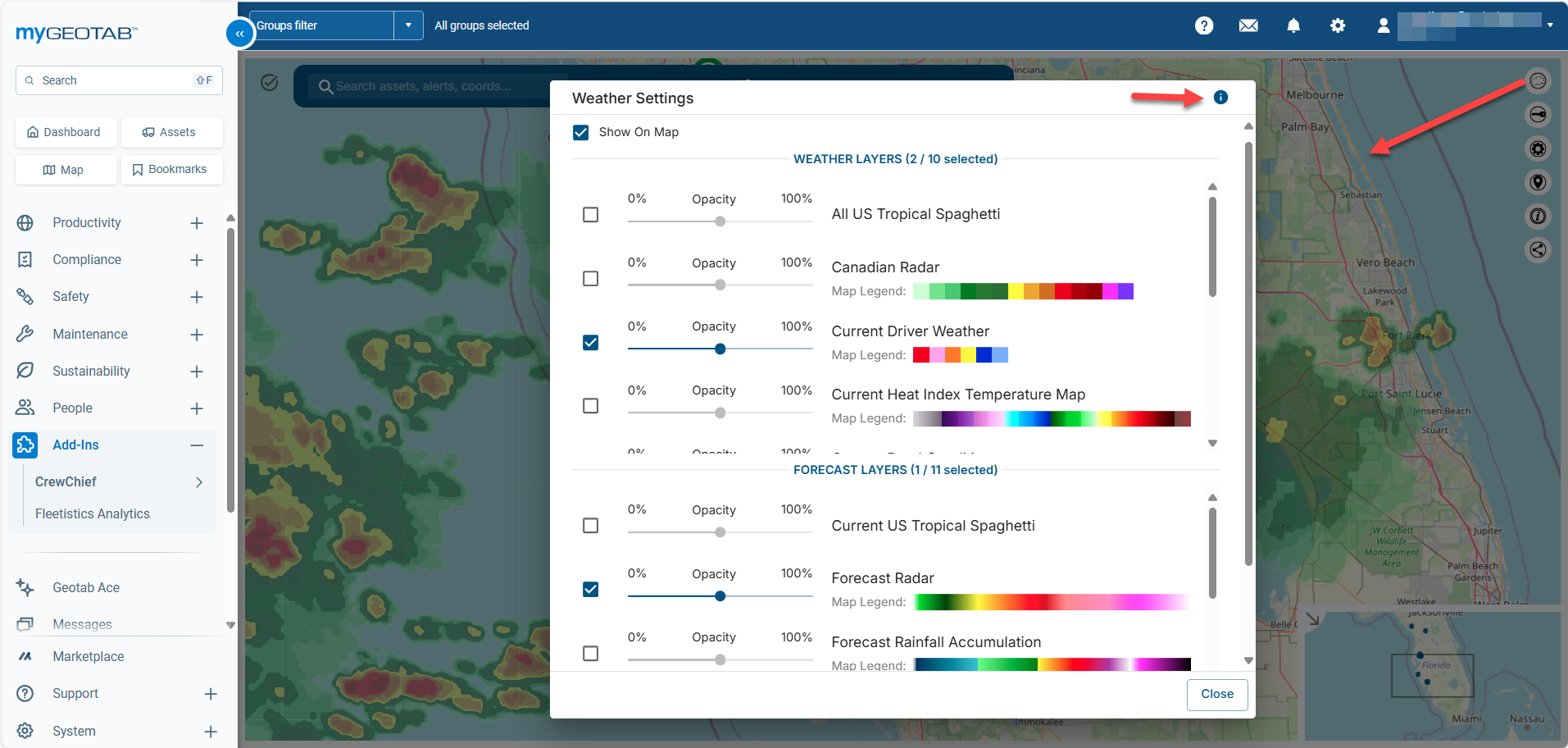Weather Layers Explained
Understanding Weather Layers
Turn layers on and off to get the weather conditions you need to safely and efficiently operate your fleet.
Current Weather Layers
Driver Weather
Weather Conditions can change quickly. Know conditions experienced by your vehicles in real-time. Track the following weather- Precipitation Type/Intensity and Fog Density. Advanced weather processing provides the localized weather conditions that put drivers at risk of an accident.
IR Satellite
Satellite imagery is useful when tracking tropical storm activity.
Lightening
Lightning detection including polarity and severity in real-time as it relates to your vehicles.
National Weather Service Watches & Warnings
Know when your vehicles are entering an area that’s under an NWS watch or warning.
Observations
Displays temperature, dew point, wind speed/directions, weather condition, and visibility across the country.
Radar
This product offers a composite image of precipitation. Through advanced algorithms, the data projects not only the intensity of precipitation, but whether it’s rain, ice, or snow.
Road Conditions
Track the following Road Conditions – wet, flooded, patchy ice, ice covered, snow, and heavy snow.
Roadway Threats
Road Conditions, Fog, and Precipitation are not the only threats to a driver’s safety and your customers’ vehicles. Hail, Tornados, and High Winds can put your driver at risk.
Temperate (North America)
From extreme cold to heat, temperatures impact your customers’ operations, field workers, and driving conditions.
Wind Speed (North America)
The wind speed map gives you a visual of all winds more than ten mph, so customers can see where high or gusty winds may impact operations.
Wind Speed & Direction
Track wind speed and direction out over the next 60 hours.
Wind Chill Temperature
The perceived decrease in air temperature felt by the body on exposed skin due to the flow of cold air. Wind chill temperature is defined only for temperatures at or below 10 °C (50 °F) and wind speeds above 4.8 kilometers per hour (3.0 mph).
Forecast Weather Layers
Future Scan Radar
Future Scan Radar provides a one-hour forecast of radar imagery.
Severe Storm Probability
Know if your vehicles and employees are in areas where dangerous weather is expected. Data’s Severe Storm Probability provides a three-day severe weather forecast. Areas are highlighted based on the following criteria; Storms, Slight Risk of Severe Storms, Enhanced Risk of Severe Storms, Moderate Risk of Severe Storms, and High Risk of Severe Storms.
Tropical Storm Forecast
See the official National Hurricane Center forecast – as it updates. An NHC forecast shows the expected strength and direction of a tropical event, including tropical storms and hurricanes.
Spaghetti Models
Spaghetti Models help your customers gauge their confidence in a National Hurricane Center Forecast. See all possible forecast tracks of a Hurricane or Tropical Storm.
Snowfall Accumulation
Hourly snowfall accumulation allows you to see how much snow is expected to fall and when conditions will deteriorate.
Rainfall Accumulation
Flash Flooding is one of the most deadly forms of severe weather. Rainfall Accumulation Maps help you see where the heaviest rainfall will occur, helping drivers avoid dangerous areas.
Road Conditions Forecast
Track the following Road Conditions- wet, flooded, patchy ice, ice covered, snow, and heavy snow.
Weather Definitions
Current Driver Weather
Fog (current weather): Visibility restriction affecting the sight-distance of a driver.
Heavy Fog (current weather): Urgent visibility restriction reducing visibility on the order of car lengths.
Light Rain: Rain that causes no visibility restriction but makes the road slippery.
Moderate Rain: Rain that causes some visibility restrictions.
Heavy Rain (current weather): Rapid rate of rain that is capable of quickly covering the roadway. Hydroplane possibilities increased.
Snow: Light to Moderate snow that may cause isolated travel problems.
Heavy Snow (current weather): Rapid rate of snowfall that quickly accumulates and reduces visibility. Travel problems are likely in these areas.
Ice: Freezing rain, sleet, or mixed wintry precipitation, capable of producing isolated travel problems.
Heavy Ice (current weather): Rapid rate of freezing rain, sleet, or mixed wintry precipitation, capable of quickly producing widespread travel problems and damage to trees and power lines.
Road Conditions
Snow (road condition): Snow in an amount covering (or just partially covering) secondary and less-travelled roads.
Heavy Snow (road condition): Snow in an amount covering major roadways and interstates
Patch Ice (road condition): Patchy ice, with bridges likely to experience issues and isolated patches of black ice.
Ice (road condition): Ice covered roads resulting in significant travel impacts.
Flood: Ponding on roads in areas and possible flash flooding.
Wet: Wet or damp roads, no ponding expected.
Threats/Hazards
Dangerous Wind: Crosswinds exceed 35mph, the critical threshold for high profile vehicles.
Hail: Based on Data’s patented storm tracking, highlights areas where Severe Hail is possible over the next fifteen minutes.
Twisting Wind: Based on Data’s patented storm tracking, highlights areas where Tornados are possible over the next fifteen minutes.

